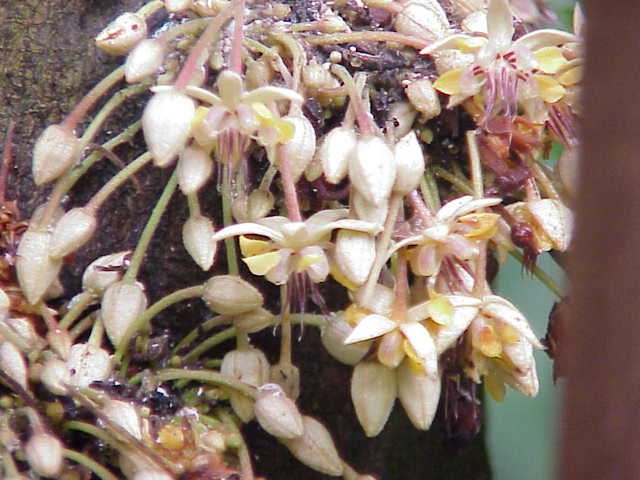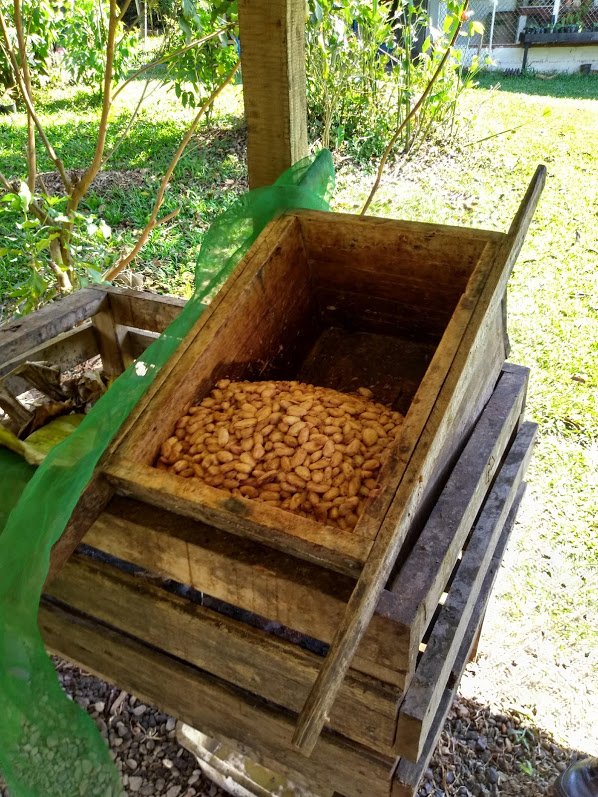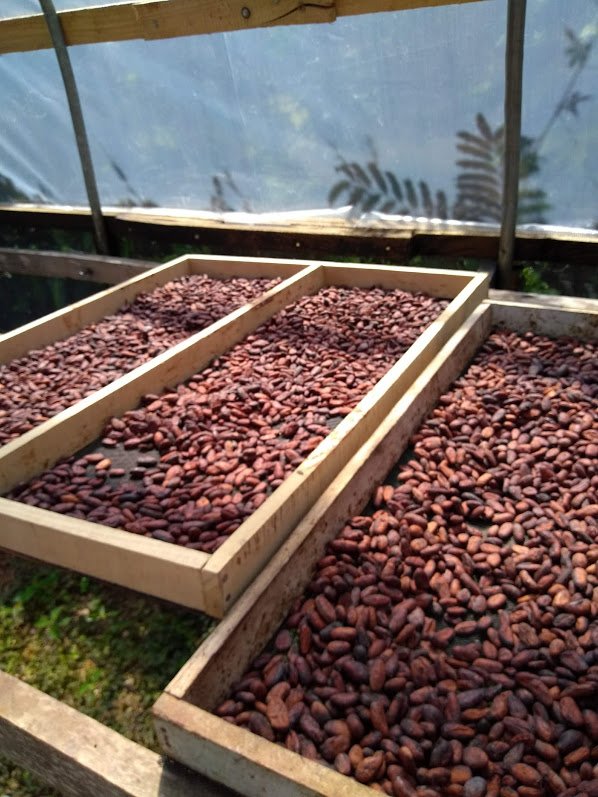Costa Rica - Part 5 - Cacao
Introduction
After Vanilla, my favorite plant-derived natural product is chocolate. I was delighted to find that in addition to Vanilla, Villa Vanilla(a small biodynamic, organic farm near Tulemar in Costa Rica), also grows and processes Cacao, Theobroma cacao, from which chocolate is derived. This was my first time seeing the entire process of chocolate production from plant to chocolate bar!

Cacao pod on Theobroma cacao tree at Villa Vanilla (photograph by D. Rhodes).
Botany
Theobroma cacao is a relatively small tree of the Malvaceae family of angiosperms. The name translates to "Food of the Gods" (theos = Greek name for God; broma = Greek name for food). Flowers of Theobroma cacao are small (1 to 2 cm in diamater) and produced in clusters directly on the trunk and older branches. The flowers are pollinated by small Forcipomyia midges.

Cacao Flowers Image Source:
Ovaries of pollinated flowers develop into relatively large (15 - 30 cm long x 8 - 10 cm wide) fruit (pods or cabossides) containing 20 to 40 seeds (beans) embedded in a white pulp.


Cacao pods on Theobroma cacao trees at Villa Vanilla (photograph by D. Rhodes).
Genetics
The genome of the Criollo cultivar of Theobroma cacao was first sequenced by Argout et al. (2011) and improved format by Argout et al. (2017). Subsequently the genome sequence of the most widely cultivated type Matina 1-6 was obtained (Motamayor et al. 2013)). Cornejo et al. (2018) then sequenced 200 genomes of the chocolate plant Theobroma cacao and based on these sequences have suggested that the Criollo population (the variety first cultivated by the Mayas (Motamayor et al. (2002)) underwent strong domestication ~3600 years ago, with strong selection for genes involved in the metabolism of the colored protectants (anthocyanins) and the stimulant theobromine, as well as disease resistance genes. However, the Criollo cultivar has developed and maintained a higher proportion of deleterious mutations as a result of domestication (Cornejo et al. (2018)).
Pods may differ in color between cultivars of Cacao, largely due to variable expression of a transcription factor that regulates anthocyanin pigmentation in other angiosperms (Motamayor et al. (2013)).
The recent developments in Cacao genomics, in vitro embryogenesis and genetic transformation of Cacao is spurring commercial interest in developing genetically modified (GM) Cacao varieties with enhanced traits, including disease resistance. However, no GM Cacao has yet been released for commercial production, partly because of the uncertainties surrounding consumer acceptance of GM foods (Wickramasuriya and Dunwell (2018)).
Cacao seed fermentation

Cacao seeds are removed from the pods and fermented on site at Villa Vanilla in wooden boxes (photograph by D. Rhodes).

Fermented seeds are then dried (photograph by D. Rhodes).
Seed coats are removed and dried cotyledons converted to chocolate in a Conching machine (not shown here, but illustrated in Verna (2013)) on site at Villa Vanilla. Various ingredients can be added at this stage, including milk, vanilla, extra cocoa butter or other spices to produce chocolates with different flavors, aromas and textures.
The seeds are the main ingredient in chocolate, and are rich in fats (cocoa butter), antioxidants (mostly flavonoids/polyphenols), micronutrients (magnesium and zinc), the stimulant theobromine, the serotonin precursor tryptophan, biogenic amines (serotonin-like monoamines), and cannabinoid-like fatty acids (Verna (2013), Palczewski and Kiser (2013), Bruinsma and Taren (1999)). The latter may contribute significantly to "chocolate cravings" (Bruinsma and Taren (1999), Palczewski and Kiser (2013)).
Key to chocolate quality is the rich array of microorganisms (including yeasts, acetic acid bacteria and lactic acid bacteria) involved in the fermentation process (Lima et al. (2011), Jespersen et al. (2005), Ludlow et al. (2016), Schwan (1998)). The process of fermentation involves significant reduction in polyphenols (epicatechin and catechin) and alkaloids (methylxanthines, caffeine and theobromine) found in raw cocoa beans that give rise to bitterness and unpleasant astringency. Flavor precursors such as organic acids, reducing sugars and free amino acids are produced towards the end of the fermentation process (Wickramasuriya and Dunwell (2018)).
Theobromine
Although chocolate contains a small amount of the methylxanthine, caffeine (also found in coffee and tea), the main methylxanthine of chocolate is theobromine which differs from caffeine by a single methyl (CH3) group (Ashihara et al. (2011), Ashihara et al. (2017)). The pathway of synthesis of caffeine in tea (Camellia) and coffee (Coffea) is shown below, and involves the action of 3 methyltransferase that sequentially add CH3 groups to the xanthine ring. The methyl donor for all three N-methylation reactions is S-adenosylmethionine (AdoMet):

One biosynthetic route of caffeine, as performed by Camellia and Coffea species Image Source:.
Note that theobromine is the immediate precursor of caffeine in coffee and tea, and the implications are that Theobroma cacao lacks significant activity of caffeine synthase responsible for converting theobromine -> caffeine. This pathway appears to have evolved independently in a number of different plant species (Huang et al. (2016)).
Cocoa
In addition to chocolate, Theobroma cacao seeds are used to obtain cocoa, a dry, powdered non-fat product (Ellam and Williamson (2013)) with human health benefits:
Nutritionally, cocoa contains biologically active substances that may affect human health: flavonoids (epicatechin and oligomeric procyanidins), theobromine, and magnesium.
Additional reading
Much has been written about the history and science of chocolate and its impacts on human health, and I refer the reader to excellent books and articles on these subjects by Beckett (2000), Wilson and Hurst (2015), Lippi (2013), Ellam and Williamson (2013), and Dillinger et al. (2000) cited in the References section below.
In my opinion, chocolate is an acquired taste (photograph of the author)!
References:
Beckett, S. The Science of Chocolate (2nd Edition; Royal Society of Chemistry)(2000)
Bruinsma, K., Taren, D.L. Chocolate: food or drug? J. Am. Diet. Assoc. 99: 1249-1256 (1999)
Ellam, S., Williamson, G. Cocoa and human health. Annu. Rev. Nutr. 33: 105-128 (2013)
Lippi, D. Chocolate in history: food, medicine, medi-food. Nutrients 5: 1573-1584 (2013)
Palczewski, K., Kiser, P.D. Biochemistry. As good as chocolate. Science 340: 562-563 (2013)
Verna, R. The history and science of chocolate. Malays. J. Pathol. 35: 111-121 (2013)
Previous articles in this series:
Costa Rica - Part 1 - The Sloth Institute Costa Rica
Costa Rica - Part 2 - Scintillating Sunsets

This post has been voted on by the SteemSTEM curation team and voting trail in collaboration with @utopian-io and @curie.
If you appreciate the work we are doing then consider voting all three projects for witness by selecting stem.witness, utopian-io and curie!
For additional information please join us on the SteemSTEM discord and to get to know the rest of the community!
Thank you!
Hi @davidrhodes124!
Your post was upvoted by Utopian.io in cooperation with @steemstem - supporting knowledge, innovation and technological advancement on the Steem Blockchain.
Contribute to Open Source with utopian.io
Learn how to contribute on our website and join the new open source economy.
Want to chat? Join the Utopian Community on Discord https://discord.gg/h52nFrV
Great article about something I was recently looking for more information. I like bitter unsweetened chocolate, and I've wondered about the raw product. Nice trip!
Great read! Your high-quality natural product content was selected by a @nunesso currator. We just gave you a small upvote together with our many followers of the @nunesso blog.
Have you heard of @nunesso? Using the #nunesso or #naturalproducts tag rewards authors and content creators who produce exceptional natural product related articles, so be sure to use our tag and get much bigger upvotes, resteems and be featured in our curation posts!
Love the science behind your post, well done and thanks for all the information on cocao. More to come on the cocao bean, we're sure. Best regards @nunesso
Posted using Partiko Android
Thank you, I just became aware of the #naturalproducts tag yesterday and it seemed highly appropriate to use here. Best regards, Dave R.
Absolutely. Your post was right up the ally of what should be expected for a high quality post. The #naturalproducts tag needs to have these types of posts. Thumbs up.
Posted using Partiko Android